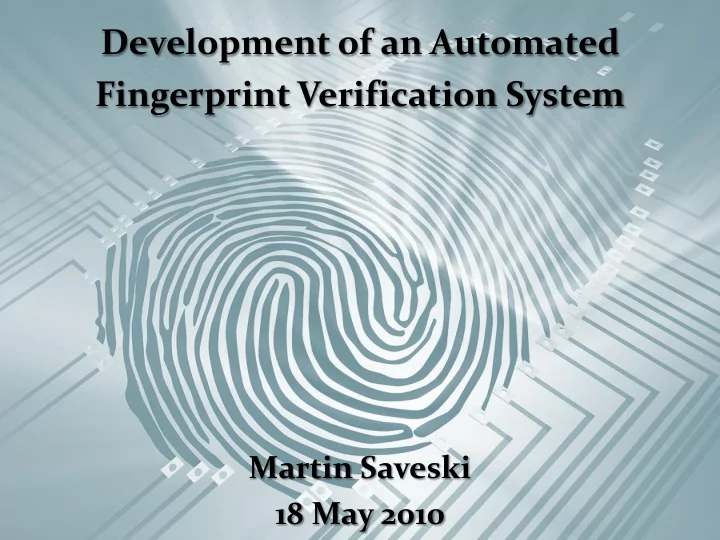

Development of an Automated Development of an Automated Fingerprint Fingerprint Verification System Verification System Martin Saveski 18 May 2010
Introduction Biometrics – the use of distinctive anatomical and behavioral characteristics or identifiers for automatically recognizing person Fingerprints are considered to be immutable Probability that two fingerprints are identical is: 1 / 1900000000000000 Manual recognition is slow and labor intensive Inspiration for many IP and PR researchers
Fingerprint Representation Depending on the different scales of analysis and types of features, FP patterns are structured in 3 levels: 1) Global level 2) Local level 3) Very fine level
Global Level Examines the line flow of the ridges Singular points: loops and deltas identified. Global Features (FVC2000, DB2, FP Impression 103-2)
Local Level Identifies local ridge characteristics Common characteristics called minutiae are: ridge endings , and bifurcations Local Features Minutiae (Maltoni et al., 2009)
Very Fine Level Intra-ridge details width shape curvature edge contours Most important: swear pores Very-fine Level Considered to be highly Features distinctive (Maltoni et al., 2009)
Main Stages Fingerprint Segmentation Image Enhancement Normalization Orientation Estimation Frequency Estimation Filtering Binarization Skeletonization Feature Extraction (Minutiae) Fingerprint Matching
Fingerprint Segmentation Separates foreground from background regions Fingerprint regions have higher gray scale variance Before Segmentation After Segmentation (Original image taken from: FVC2000, DB2, FP Impression 105-8)
Fingerprint Image Enhancement The quality of ridge structure of the FP image is essential for successful feature extraction Gabor Filtering adopted Both frequency and orientation selective The main steps: Normalization Orientation Estimation Ridge Frequency Estimation Filtering
Gabor Filter Normalized Image Enhanced FP Orientation Image Estimation FP Frequency Estimation
Normalization Ensures that the image has a specified mean and variance Reduces the distortion effects along the ridges and valleys Before Normalization After Normalization (Original image taken from: FVC2000, DB2, FP Impression 107-6)
Orientation Estimation Orientation: the angle that the FP ridges crossing through an arbitrary small neighborhood form with the horizontal axis Normalized Image Orientation Estimations (Original Image taken from: FVC2000, DB2, FP Impression 107-6)
Ridge Frequency Estimation Computed by projecting the grayscale values around the orientation orthogonal This projection has sinusoidal form where the ridges are local minima The spacing between the ridges is estimated by counting the median number of pixels between consecutive minima points The frequency is: 1 / spacing between the ridges
Filtering Orientation and Frequency estimations used for calculating the masks for each block Removes the noise while preserving the ridge structure Original FP Image Enhanced Image (Original Image taken from: FVC2000, DB2, FP Impression 101-5)
Binarization Grayscale -> Binary Image Improves the contrast between the ridges and valleys Global binarization VS Local binarization Enhanced Image Binary Image (Global Threshold) (Original Image taken from: FVC2000, DB2, FP Impression 105-2)
Skeletonization Thinning the foreground regions until one pixel wide Morphological skeletonization is not suitable, it does not guarantee connectivity More sophisticated method adopted (Gonzalez & Woods, 2008) Binary Image Skeletonized Image (Original Image taken from: FVC2000, DB2, FP Impression 101-2)
Minutiae Extraction Performed by using the concept of Crossing Number All minutiae extracted by a simple image scan of the skeletonized image CN = 1, correspond to ridge ending CN = 3, corresponds to bifurcation
Minutiae Extraction (cont.) All minutiae stored as (x, y, θ , CN) quadruples where, x, y: the spatial coordinates θ : orientation CN: the Crossing Number Skeletonized Image Minutiae Detected (Original Image taken from: FVC2000, DB2, FP Impression 101-2)
Fingerprint Matching Determines the degree of similarity between two fingerprint images Attempts to find the alignment of the images which will result in maximum number of minutiae pairings Must cope with Displacement Rotation Non-linear distortion Noise
Fingerprint Matching (cont.) The matching algorithm adopted consists of 3 steps: 1) Registration 2) Minutiae Pairing 3) Matching Score Computation
Fingerprint Matching (cont.) Registration: is finding the ‘best’ transformation which when applied to the one of the images will result in maximum overlapping minutiae. Minutiae Pairing: minutiae are paired if their difference in x, y, θ is within the range of the tolerance box. Matching Score: m – paired minutiae, n - minutiae within the bounding box
Performance Evaluation A subset of the Fingerprint Verification Competition 2000 (FVC) Database 2 was used 10 fingers wide 8 impressions deep Performance Measures defined by FVC and widely adopted in the research community, Genuine Matching Score - gms Impostor Matching Score - ims False Match Rate above threshold t - FMR(t) False Non-Match Rate above threshold t - FNMR(t) Equal Error Rate - (EER) EER is a single value which assesses the performance of the system
Performance Evaluation (cont.) The Equal Error Rate of the system developed was 35% The chart below show the FMR(t) and FNMR(t) curves 100% 90% 80% 70% 60% 50% 40% 30% 20% 10% 0% 0 0,1 0,2 0,3 0,4 0,5 0,6 0,7 0,8 0,9 1 False Mathcing Rate False Non Mathcing Rate (AFVS, FMR and FNMR evaluation curves)
Future Work Filtering Extracted Minutiae : Technique which detects and filters spurious minutiae Significant improvement of the performance Fingerprint Classification: Classification of DB samples Reduced number of comparisons Improved response time
Questions
Thank You For Your Attention
Recommend
More recommend